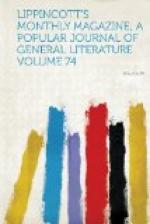upon a book requiring a good deal of thought.
Very frequently I would be unable to solve certain
problems, but leaving them would find a day or two
afterward, on taking pen in hand, that the solution
traced itself without effort on the paper clearly
and logically. During the sleeping hours, or
during the waking hours of a busy professional life,
the brain had, without my consciousness, been solving
the difficulties. This experience is by no means
a peculiar one. Many scientific workers have
borne testimony to a similar habit of the cerebrum.
The late Sir W. Rowan Hamilton, the discoverer of
the mathematical method known as that of the quaternions,
states that his mind suddenly solved that problem
after long work when he was thinking of something else.
He says in one place: “Tomorrow will be
the fifteenth birthday of the quaternions. They
started into life or light full grown on the 16th of
October, 1843, as I was walking with Lady Hamilton
to Dublin and came up to Brougham Bridge; that is
to say, I then and there felt the galvanic circle of
thought closed, and the sparks which fell from it
were the fundamental equations between
I, F
and
K exactly as I have used them ever since.
I felt the problem to have been at that moment solved—an
intellectual want relieved which had haunted me for
at least fifteen years before.” Mr. Appolo,
a distinguished scientific inventor, stated in the
Proceedings of the Royal Society that it was his habit
to get the bearings and facts of a case during the
day and go to bed, and wake the next morning with
the problem solved. If the problem was a difficult
one he always passed a restless night. Examples
might be multiplied. Sir Benjamin Brodie, speaking
of his own mental action, states that when he was unable
to proceed further in some investigation he was accustomed
to let the matter drop. Then “after an
interval of time, without any addition to my stock
of knowledge, I have found the obscurity and confusion
in which the subject was originally enveloped to have
cleared away. The facts have seemed all to settle
themselves in their right places, and their mutual
relations to have become apparent, although I have
not been sensible of having made any distinct effort
for that purpose.”
Not only is there such a thing, then, as unconscious
thought, but it is probable that the best thinking
is rarely, if ever, done under the influence of consciousness.
The poet creates his work when the inspiration is
on him and he is forgetful of himself and the world.
Consciousness may aid in pruning and polishing, but
in creating it often interferes with, rather than
helps, the cerebral action. I think any one of
my readers who has done any literary or scientific
writing will agree that his or her best work is performed
when self and surrounding objects have disappeared
from thought and consciousness scarcely exists more
than it does in a dream. Sometimes the individual
is conscious of the flow of an undercurrent of mental




